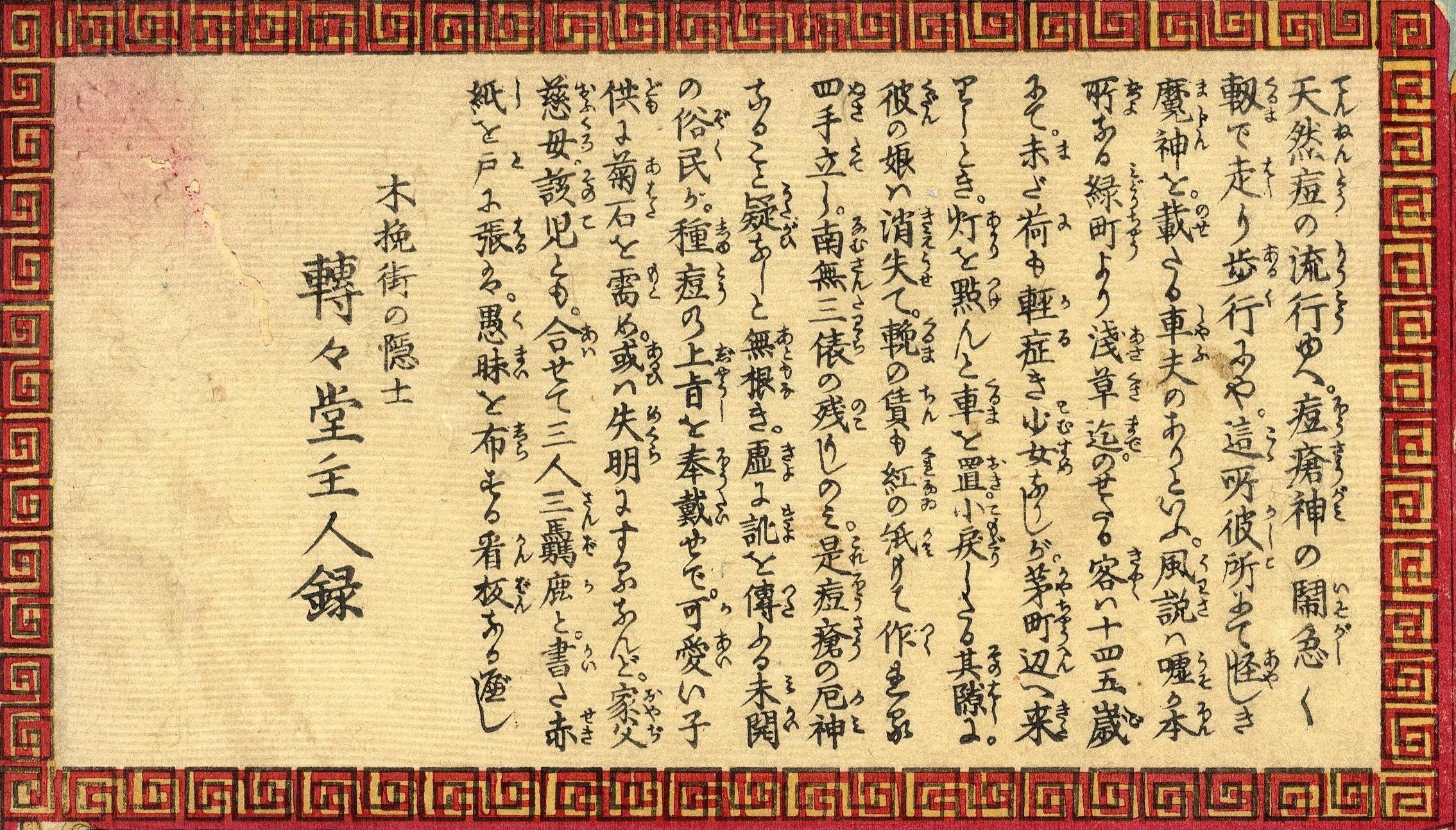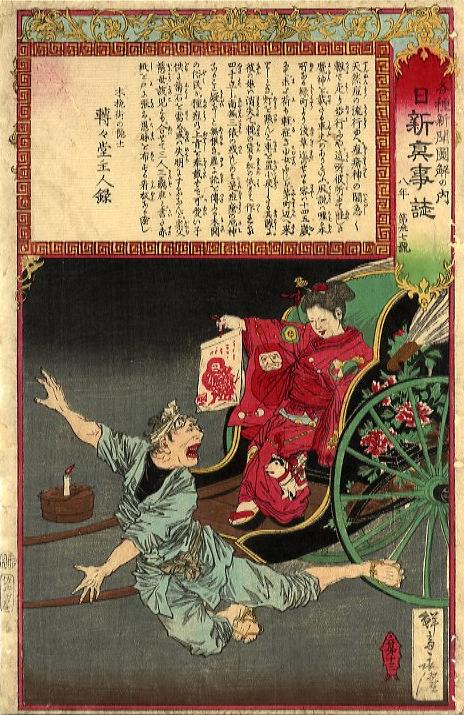Transcription and translation
In the following transcription, I have shown first the graphic text without the ever-important furigana, without which the text would not be language. By this I don't mean that the text without the furigana does not represent language, but that the language would be left to the reader's imagination, because the intended language is not self-evident in the graphic representation unaided by furigana. The kanji don't pronounce themselves. And context does not necessarily constrain reading choices to the intended reading.
While the text is shown as a continuous stream of script with no punctuation, the writer has marked where phrases are to be broken when reciting the story. I have shown the phrases as distinct lines for the purposes of illustrating their linguistic (stylistic and poetic) qualities.
I have romanized the text linguistically rather than graphically. By this I mean that I transliterated the phonetic in-line kana and the furigana alongside the graphic kanji, thus bypassing all kanji except the very few that are left to the reader to linguistically articulate.
The translation is intended to stay fairly close to the structural quality of the original text. In this regard, I have endeavored to translate each lineated phrase in tact. In a couple of places, however, I have mixed sub-phrases in adjacent lines to accommodate English preferences -- or, rather, because I gave up trying to come up with English phrasing that satisfied the Japanese structures.
天然痘の流行ゆえ。
痘瘡神ハ鬧急しく(車刄)で走り歩行にや。
這處彼所にて怪しき魔神を。
載たる車夫のありといふ。
風説ハ嘘か本所ある緑町より浅草迄。
のせたる客ハ十四五歳にて。
未だ荷も軽症き少女ありしが。
茅町辺へ来りしとき。
灯を點けんと車を置。
小戻しさる其隙に。
・・・
Tennentou no riukiyu yue. (7 + 6)
tousaugami wa isogashiku kuruma de hashiriaruku ni ya. (7 + 5 / 12)
Koko (??) nite ayashiki majin o. (6 + 8)
nosotaru shafu no ari to ifu. (7 + 5)
uwasa wa uso ka Honjiyo aru Midori-chiau yori Asakusa made. (7 + 6 / 13)
nosetaru kiyaku wa juu-yon, -go (de?) nite. (8 + 8)
ni mo karaki ko-musume arishi ga. (7 + 8)
Kaya-chiau hen e kitarishi toki. (8 + 6)
akari o tsuken to kuruma o oki. (7 + 7)
komodori shitaru sono (??) ni. (7 + 5)
. . .
On account of a contagion of smallpox
the pox god is busily running around in a carrage.
Here and there the ominous demon god
is given a ride by a carriage runner,
rumors of which, whether true, as for the customer,
there was a girl of 14, 15, whose burden was yet light,
who was given a ride from Midori in Honjō to Asakusa,
and when [the they] came to the vicinity of Kaya-chau,
[the runner, saying he] would light a lamp, parked the carraige,
and in the time he stepped back,
. . .
 "Smallpox goddess" story cartouche, Kakushu shinbun zukai no uchi No. 13, Nisshin shinjitsu shi Issue 37, Yosha Bunko scan
"Smallpox goddess" story cartouche, Kakushu shinbun zukai no uchi No. 13, Nisshin shinjitsu shi Issue 37, Yosha Bunko scan
|
Sensai Eitaku
Kobayashi Eitaku (1843-1890) was one of the most talented drawers of the Meiji period. The entire KSZU series, but especially this Shogitai print, shows an originality of composition and color seldom seen in contemporary woodblock prints.
Ono Hideo waxed almost elegant about the comparatively unknown Eitaku (Ono 1972:8-9).
|
Eitaku, whose real name was Kobayashi Shutaro, was born in Edo in the 14th year of Tenpo (1834). His family sold fish, but early on he studied the Kano Eitoku style of drawing and was patronized as a Kano-school drawer by the House of Ii of daimyo fame. Later he moved to Tokyo and turned to drawing pictures of customary life. After this, he drew customary scenes in the ukiyoe style, but he never lost his Kano-school methods. Compared with Utagawa-school drawings, his are said to lack softness. However, compared with Yoshiiku who adopted bold colors, and with Yoshitoshi who imitated Hokusai-style lines, there is the added flavor of an oil painting in Eitaku's drawings. On this point, his drawings are totally different from those of the two Utagawa-school ukiyoe drawers. |
Eitaku later worked as an illustrator for Eiri jiyu shinbun, and Ono says his newspaper line drawings showed the same tendencies toward realism and calmness. (WW)
Tentendo Dondon
The story on the print is signed Tentendo Dondon, who wrote all the stories in the KSZU news nishikie series drawn by Saisen Eitaku. Tentendo Dondon is a pen name of Takabatake Ransen. His most common name on woodblock prints appears to have been Tentendo Shujin. At times, but rarely, he signed a print as Takabatake Ransen, the name by which he was best known as a gesaku writer.
Print information
Series: Kakushu shinbun zukai no uchi
Number: 13
Source: Nisshin shinjitsu shi No. 37 (Unconfirmed date)
Date: 1875-2 (seal)
Publisher: Saitaya (Saitaya Ichizō 佐井田屋市造)
Drawer: Sensai Eitaku (Kobayashi Eitaku)
Carver: Unstated
Writer: Tentendo Dondon (Takabatake Ransen)
Size: Oban
Image: Yosha Bunko
Principal sources
Tsuchiya 2000
